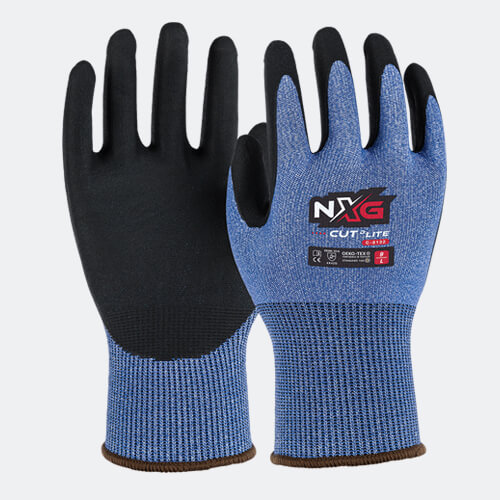
Cut 5 VS Cut D Gloves.
Following the revamp of the EN 388 standard, customers are getting confused and asking what is the difference between Cut 5 gloves and Cut D gloves etc, in the below article we explain the difference between Cut 5 and Cut D in simple terms to help make this easier to understand.
So what is Revised EN388 standard?
Work gloves are now put through a far more rigorous straight blade test in order to define their ability to protect against cut hazards, this has meant that cut resistant gloves now have higher levels of protection they can be tested to.
Choosing the right safety gloves for your particular task is vital to ensure proper protection.
Throughout the world, safety gloves are rated using the European Standard, EN388, to determine their level of protection. The standard consists of a series of tests to assess fabric for its ability to withstand heavy rubbing, cutting by a blade or sharp object, tearing and puncture. The gloves are then rated based on the result.
The cut test used by the EN388 standard has been upgraded which will change the rating markings shown on protective gloves.
EN388 Testing Process
The Coup cut test for the old EN388:2003 standard was conducted with a rotating blade, like a pizza cutter, under a standard weight with the material laid out on a flat surface. The blade was moved back and forth over the fabric until a cut was detected, and the safety level determined by the number of times the blade passed across.
However, the rise of new cut-resistant fibre technology has uncovered limitations in the Coup test. Gloves rated at level 5 could cover a wide range of protection – meaning gloves with vastly different levels of performance could all be classified under the same level.
A new cut-level test was needed to more accurately reflect the true safety level.
The new standard, EN388:2016, was updated in November 2016 to apply a new test, ISO 13997, to the existing mechanical hazards performance tests. This upgrades the standard to be more relevant to modern real-life applications and fabrics. The new cut test method was adopted from the ISO 13997 standard to overcome those limitations.
Testing for the EM388 standard is carried out using an instrument called a TDM100 machine. The fabric is placed on a convex surface and a straight blade is moved across the sample under specified loads until the blade cuts through. When it comes into contact with a conductive copper strip underneath the sample, the test automatically halts.
The distance between the point of initial contact and the cut-through point is measured in millimetres. The cut resistance is calculated as a ratio of the distance the blade travels and the weight of the load.
The tests are carried out five times with each load weight, using a fresh blade each time to ensure accuracy
The level D cut resistant gloves offer high levels of cut protection having passed a straight blade test of up to 15 newtons of force, ideal where there is a higher risk of cuts from hazards.
How will safety glove markings change?
Safety glove markings will be updated to include the results of the new ISO 13997 cut test.
The current 4 performance values shown under the EN388 ‘Hammer Shield’ icon indicating Abrasion, Cut (Coup test), Tear and Puncture
will remain. However, should the material dull the blade under the Coup Test, the second digit will get a “X” and will be tested under the ISO 13997 cut test. A letter (A-F) showing the result of the new cut test will be added to the right-hand side of the current 4 digits. A indicates the lowest rating with F being the highest rating.
A new Impact protection result may also be added to the markings for gloves tested for back-of-hand protection. This will be indicated with a P (pass), F (fail) or X (not tested).
Industroquip believes testing under the EN388:2016 standard allows for a more accurate grading, particularly for cut resistance. This will
enable choosing the most appropriate gloves to match the risks of your activity.

So in simple terms what is the difference?
In very simple language this means that a Cut D level gloves can be up to 5 times more cut resistant when compared with Cut 5 level gloves because not all of the Cut 5 gloves were tested the same testing process, so we are recommending our customers use the Cut D level gloves even though its not yet an Australian Standard just to ensure the very best in hand protection for their staff.
For more information reach out to our team on 1300554192 or sales@industroquip.com.au

Leave a Comment